|
Author
|
Topic: ISS: Starboard solar alpha rotary joint (SARJ) repair
|
Robert Pearlman
Editor Posts: 46881
From: Houston, TX
Registered: Nov 1999
|
 posted 10-28-2007 05:08 PM
posted 10-28-2007 05:08 PM
   
The International Space Station has on each end of its truss a motorized joint that allows its solar panels to rotate, such that they can track the sun. 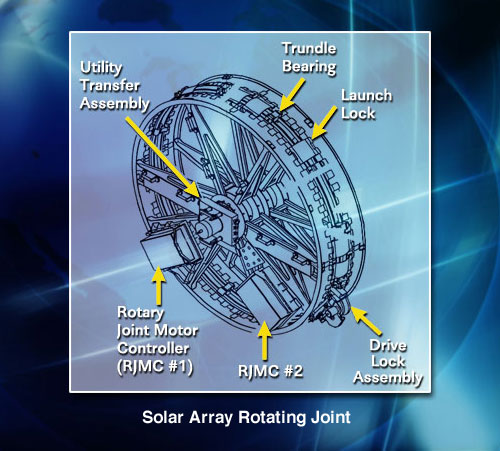 About 50 days ago, a station flight controller just happened to notice that a camera mounted to the starboard solar array truss was vibrating ever so slightly. Upon investigating the issue, it was discovered that the 10-foot wide joint assembly was requiring more electricity to rotate than what was considered normal. This suggested to mission managers that something was impeding its movement. The only way to know for sure would be to get a firsthand look, so flight controllers took advantage of STS-120 being at the station and today, during the second of the mission's five planned spacewalks, asked newly-arrived ISS Expedition 16 flight engineer Dan Tani to inspect the Solar Alpha Rotating Joint (SARJ, pronounced "sarge") that was giving them trouble (the additional inspection still allowed for Tani and his spacewalking partner Scott Parazynski to complete their pre-scheduled activities, with the exception of connecting the electrical wiring to a new robotic arm grappling point on the Harmony module). After looking over the exterior of the SARJ, which appeared normal, Tani unbolted one of the 22 thermal covers that protects the joint's gears and made a discovery. "It's quite clear," radioed Tani, "there's metal-to-metal scraping, or something, and it's widespread." 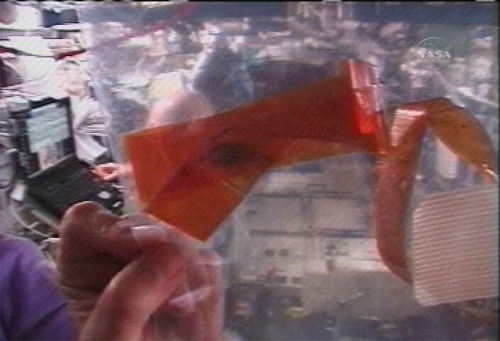 Tani observed what he believed to be metal shavings. At the suggestion of flight controllers, he used tape to collect some of the debris to bring it inside to be photographed and then returned to Earth on shuttle Discovery for further study. The leading theory as to the source of the filings, at least as of now, is the aluminized mylar foil that lines the bottom of the thermal covers. If that material rubbed up against the teeth of the SARJ, it could have been gradually but thoroughly shredded to cause the debris observed by Tani. Mission managers are considering their options, including have a later spacewalk go out and inspect the remaining 21 covers for signs of the shredded mylar. If they can locate the culprit, they can remove it and then deal with cleaning up the debris. In the meantime, they have stopped the joint from tracking the sun and, with the exception of a few movements necessary for thruster firings and when the shuttle undocks, can safely leave the arrays in a static position. Even with half of them parked in place, the solar arrays generate enough electricity to support the current configuration of the station. Which leaves the question of future additions, including ESA's Columbus module, scheduled to launch in December. According to Michael Suffredini, NASA's ISS manager, even without a functioning starboard SARJ, the station should be able to support Columbus' arrival, though further study is needed to determine if enough power is present for the European laboratory's science payloads to be activated once on orbit. If need be, there are back-up components that could be used to attempt a repair, some of which are already aboard the station, but that would require the time to schedule new spacewalk activities, time that is limited given the existing workload required during STS-120 and then by station astronauts after Discovery departs. |
Robert Pearlman
Editor Posts: 46881
From: Houston, TX
Registered: Nov 1999
|
 posted 10-28-2007 05:28 PM
posted 10-28-2007 05:28 PM
   
Additional images: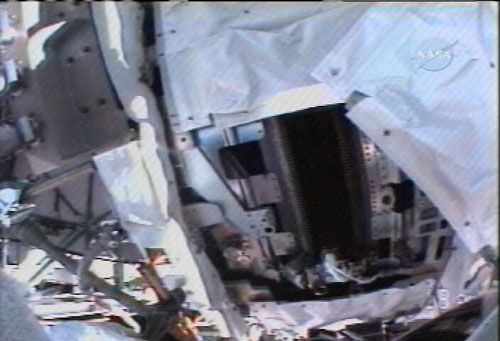
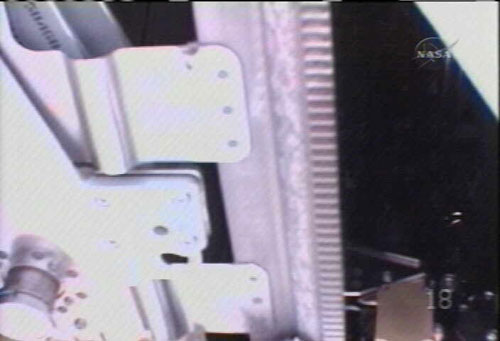 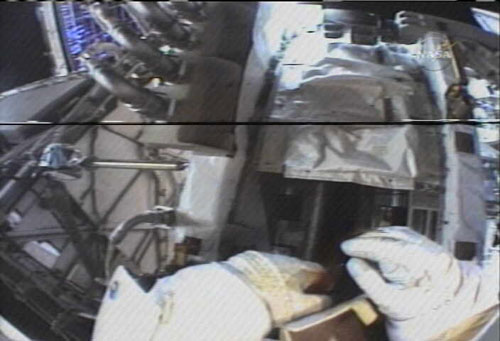
Additional reporting: |
divemaster
Member Posts: 1376
From: ridgefield, ct
Registered: May 2002
|
 posted 10-28-2007 05:37 PM
posted 10-28-2007 05:37 PM
   
You realize that the solution will include WD-40 and duct tape.
|
Jay Chladek
Member Posts: 2272
From: Bellevue, NE, USA
Registered: Aug 2007
|
 posted 10-28-2007 06:58 PM
posted 10-28-2007 06:58 PM
   
Makes sense. Considering there is a Lightsaber onboard, I am reminded of an old saying:"Duct tape is like the Force, it has a dark side and a light side and it binds the universe together."  |
GACspaceguy
Member Posts: 2726
From: Guyton, GA
Registered: Jan 2006
|
 posted 10-28-2007 07:34 PM
posted 10-28-2007 07:34 PM
   
Yes, but the funniest one was during the NASA Press conference. One reporter asked if they considered using a vacuum cleaner to get the shavings. The Engineer on the panel (I don't remember his name) let him off easy by saying he would take him aside later and talk to him about using a vacuum in a vacuum! |
Jay Chladek
Member Posts: 2272
From: Bellevue, NE, USA
Registered: Aug 2007
|
 posted 10-28-2007 09:14 PM
posted 10-28-2007 09:14 PM
   
quote:
Originally posted by GACspaceguy:
The Engineer on the panel (I don't remember his name) let him off easy by saying he would take him aside later and talk to him about using a vacuum in a vacuum!
ROFLMAO! Now that is funny, but also sad considering the education of some of these reporters covering space flight. I do hope the engineer gave him an education on it later. |
Robert Pearlman
Editor Posts: 46881
From: Houston, TX
Registered: Nov 1999
|
 posted 10-28-2007 09:34 PM
posted 10-28-2007 09:34 PM
   
quote:
Originally posted by Jay Chladek:
Now that is funny, but also sad considering the education of some of these reporters covering space flight.
You need to understand the context. The reporter in this case wasn't asking the question for his own knowledge; he knows the topic better than most. He asked the question on behalf of his readership, the public.While ISS Manager Michael Suffredini's response to the Houston Chronicle's Mark Carreau was humorous, it wasn't chiding Carreau. It came after answering the question, which was a valid one. When told of the need to clean up debris, the general public would likely think of a vacuum cleaner as a solution, so it was a good idea to get a response as to why that wasn't an option... and more importantly, what was (which even Suffredini didn't have a good answer to, yet). |
FFrench
Member Posts: 3216
From: San Diego
Registered: Feb 2002
|
 posted 10-28-2007 10:08 PM
posted 10-28-2007 10:08 PM
  
A vacuum cleaner in space? To misquote a famous movie line:"In Space... No One Can Hear You Clean"... |
divemaster
Member Posts: 1376
From: ridgefield, ct
Registered: May 2002
|
 posted 10-28-2007 10:24 PM
posted 10-28-2007 10:24 PM
   
Who said that British humour isn't funny?All kidding aside, I think I once heard on either the Discovery or History Channel that WD-40 was invented by an engineer who was working on the Atlas project. |
art540
Member Posts: 432
From: Orange, California USA
Registered: Sep 2006
|
 posted 10-28-2007 10:31 PM
posted 10-28-2007 10:31 PM
   
The WD-40 story as recited is pretty close to the truth... |
Ben
Member Posts: 1916
From: United States
Registered: May 2000
|
 posted 10-28-2007 10:44 PM
posted 10-28-2007 10:44 PM
   
Yea, to prevent them from corrosion. You can read a brief bit on it here. One of the true space (ok, ICBM) spinoffs. |
Jay Chladek
Member Posts: 2272
From: Bellevue, NE, USA
Registered: Aug 2007
|
 posted 10-28-2007 11:31 PM
posted 10-28-2007 11:31 PM
   
quote:
Originally posted by Robert Pearlman:
You need to understand the context.
Alrighty Robert, I retract that. It would make an interesting engineering challenge to overcome though, using something that can "suck" up dust particles in a vacuum. I admit my own mind has been caught up in thinking about how that might be accomplished in absense of almost total pressure. |
GACspaceguy
Member Posts: 2726
From: Guyton, GA
Registered: Jan 2006
|
 posted 10-29-2007 05:16 AM
posted 10-29-2007 05:16 AM
   
Robert, as you have mentioned before, questions are not typically asked for individual reasons rather for the readers. I just thought it was a funny question and a good response. In the terms of the general public knowledge, you are right he should have answered the question, as most people would not know why it would not work. As far as WD-40 goes, it makes a fair Corrosion Inhibiting Compound (known as CIC- there are a lot better ones out there now) and a lousy lubricant. It tends to reduce to its waxy base material and gum things up, because it is designed to stick to things. That is why it starts out working as a lubricant and picks up all kinds of grim and grit, then turns into a gritty wax ball. It was a good spin-off, as the CIC industry has grown out of it.
|
Lunar rock nut
Member Posts: 916
From: Oklahoma city, Oklahoma U.S.A.
Registered: Feb 2007
|
 posted 10-29-2007 09:16 AM
posted 10-29-2007 09:16 AM
   
I watched the live feed on this part of yesterday's spacewalk and while Tani was describing the shavings he said they were sticking to the other metallic surfaces like metal filings stick to a magnet. (Aluminum is not magnetic). See pile up in pic no. 2 of your trio. Also next to the teeth on the gear in the same photo, see light colored residue paralleling the teeth on the wheel assembly. |
Robert Pearlman
Editor Posts: 46881
From: Houston, TX
Registered: Nov 1999
|
 posted 10-29-2007 09:39 AM
posted 10-29-2007 09:39 AM
   
This photo, taken on-board the ISS, shows a clearer view of Tani's shavings stuck to the tape he used to collect them from the starboard solar alpha rotating joint.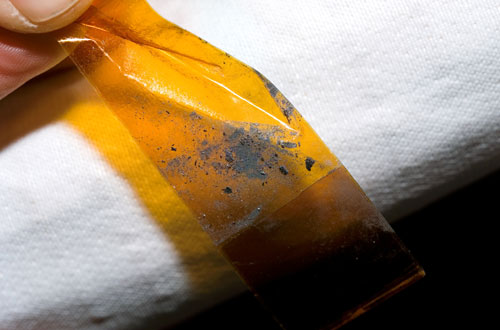 |
Robert Pearlman
Editor Posts: 46881
From: Houston, TX
Registered: Nov 1999
|
 posted 10-29-2007 10:58 AM
posted 10-29-2007 10:58 AM
   
Station managers have reached some decisions regarding further diagnosing the problem with the starboard SARJ, and have proposed further activities to be decided by the mission management team later today.On Tuesday, during STS-120's third (of five planned) spacewalks, Scott Parazynski will conduct a similar inspection to the one conducted by Dan Tani on Sunday, only this time it will be at the port (left side) SARJ, which has been operating without problem. Parazynski will remove the corresponding thermal cover to the one removed by Tani on the starboard SARJ, in an attempt to establish a "baseline" or normal condition for the joint. Normal wear and tear is expected to have created some particulate (just not as much as observed by Tani), thus Parazynski will use kapton tape to take samples of whatever debris is present. Some of the shavings collected by Tani, as pictured above, were carefully transferred by the ISS crew to a piece of white paper and a magnet was passed underneath. The filings responded to the magnet, which indicates the presence of a ferrous metal (which would exclude the aluminized mylar from that specific sample, though mylar could still be in the shavings they didn't test). Parazynski's inspection should only take about 40 minutes, still allowing time for the completion of the pre-scheduled spacewalk activities. Looking beyond EVA 3, station managers have recommended devoting the fourth spacewalk to inspecting the starboard SARJ, removing the remaining 21 blankets and collecting shaving samples if they appear to be different from what was gathered by Tani. This would require extending the length of EVA 4, which was originally intended to test a space shuttle tile repair technique, and thus would require lengthening the STS-120 mission by one day. A decision on this proposal is expected to be made later on Monday. The station program has also put forth a few ideas about changing out equipment in the starboard SARJ for the purpose of bringing the installed hardware home for study, but that work is much more complicated is not as likely to be approved. Early indications are that even without repairing the starboard SARJ, and keeping the right-side arrays in the parked position, there is enough power generation to support the STS-122 mission and the docking of ESA's Columbus module to the station in December. |
Robert Pearlman
Editor Posts: 46881
From: Houston, TX
Registered: Nov 1999
|
 posted 10-29-2007 03:05 PM
posted 10-29-2007 03:05 PM
   
As expected, mission managers have decided to extend STS-120's planned 14-day mission by one day, allowing for an extended fourth spacewalk to further inspect the starboard rotary joint. |
NavySpaceFan
Member Posts: 663
From: Norfolk, VA
Registered: May 2007
|
 posted 10-29-2007 04:41 PM
posted 10-29-2007 04:41 PM
   
If this problem prevents the station from providing enough power for both Columbus and Kibo, would NASA move up STS-119 to get additional power generation capability to ISS prior to the delivery of Kibo? |
Robert Pearlman
Editor Posts: 46881
From: Houston, TX
Registered: Nov 1999
|
 posted 10-29-2007 04:58 PM
posted 10-29-2007 04:58 PM
   
It's a good question though I suspect it is not one the program has even considered as of yet. Station managers remained optimistic today that they will be able to diagnose and address the problem with the rotary joint before the first component of Kibo is due to launch (if not also before Columbus launches, too). |
Jay Chladek
Member Posts: 2272
From: Bellevue, NE, USA
Registered: Aug 2007
|
 posted 10-29-2007 07:34 PM
posted 10-29-2007 07:34 PM
   
Does each array have its own independent SARJ or does one SARJ control the whole group on one side? As such, if the side that the planned STS-119 Solar array will be going on is the one with the SARJ problem, wouldn't the solar generation of the cells on that side be reduced anyway due to it not being able to track the sun also?If so, then I don't see the STS-119 mission flying before the SARJ problem gets fixed. |
Robert Pearlman
Editor Posts: 46881
From: Houston, TX
Registered: Nov 1999
|
 posted 10-29-2007 07:43 PM
posted 10-29-2007 07:43 PM
   
quote:
Originally posted by Jay Chladek:
Does each array have its own independent SARJ or does one SARJ control the whole group on one side?
The latter: there are only two SARJ assemblies, port and starboard. |
NavySpaceFan
Member Posts: 663
From: Norfolk, VA
Registered: May 2007
|
 posted 10-29-2007 08:38 PM
posted 10-29-2007 08:38 PM
   
quote:
Originally posted by Robert Pearlman:
The latter: there are only two SARJ assemblies, port and starboard.
Ah, did not know that. I thought each array had their own independent systems. |
Robert Pearlman
Editor Posts: 46881
From: Houston, TX
Registered: Nov 1999
|
 posted 10-30-2007 08:42 AM
posted 10-30-2007 08:42 AM
   
Scott Parazynski inspected the port SARJ during today's spacewalk, taking a look under Cover 12 (out of 22), the same cover as Dan Tani removed on the starboard rotary joint. "The raceways themselves look like they are brand new machines, no wear on any of the teeth. Looking at the raceways themselves, very, very smooth and no particulate matter there, no galling." 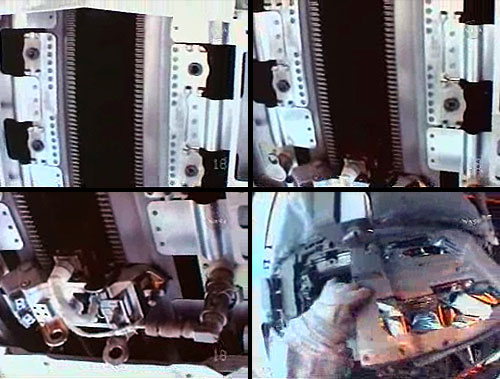 (The lower right image shows the underneath of the cover and the aluminized mylar referred to earlier in this thread.) |
Robert Pearlman
Editor Posts: 46881
From: Houston, TX
Registered: Nov 1999
|
 posted 11-24-2007 12:24 PM
posted 11-24-2007 12:24 PM
   
As he did last month during the STS-120 mission, ISS Expedition 16 flight engineer Dan Tani took time today during a spacewalk outside the space station to inspect the starboard solar alpha rotary joint (SARJ) in order to provide more information to ground controllers as to diagnose the problem that has caused the joint to malfunction. 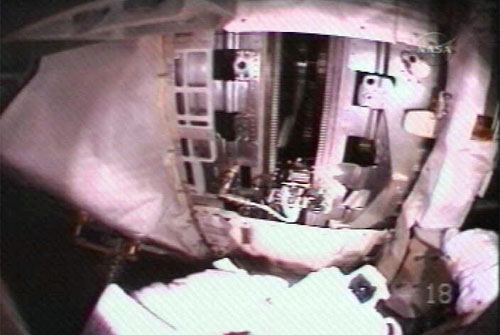 The addition of the inspection to the spacewalk, which was primarily scheduled to complete outfitting of the Harmony module, came late in the week as flight controllers are still weighing their options for similar or more extensive activities during the next shuttle mission, STS-122, set to launch early in December. After removing thermal cover no. 7 from the SARJ assembly, Tani reported seeing similar damage to what he had earlier seen under cover no. 12 in October. As with his previous report, the debris appeared to be magnetized, however upon touching the shavings, Tani was unable to detect what material he had displaced. "So it does look like the race ring may be pitted, or at lest somehow damaged," ISS Expedition 16 commander Peggy Whitson observed, having joined Tani at the inspection site. Samples of the shavings collected by Tani and returned to Earth by STS-120 were subsequently identified as the same metal alloy as the race ring, the track on which the joint rotates. "I agree it's damaged," Tani replied. "I don't think it's just on top." Whitson and Tani took digital photos of the race ring before leaving the area. The thermal cover Tani removed was not reattached; rather, sometime after STS-122, controllers plan to use a camera on the end of the station's robot arm to view the rotary joint in motion. |
jameskelley97
New Member Posts: 6
From: New York
Registered: Nov 2007
|
 posted 11-24-2007 02:24 PM
posted 11-24-2007 02:24 PM
   
How are going to come up with idea on what may be wrong with it? |
Robert Pearlman
Editor Posts: 46881
From: Houston, TX
Registered: Nov 1999
|
 posted 11-24-2007 02:29 PM
posted 11-24-2007 02:29 PM
   
quote:
Originally posted by jameskelley97:
How are going to come up with idea on what may be wrong with it?
Space station flight director Derek Hassmann described the situation after today's spacewalk (transcript courtesy Bill Harwood/CBS): What I gathered from today, and of course the engineers are going to go off and talk about this in great detail, but basically the damage is significant and is widespread. I'm not qualified or ready to draw conclusions here today, but we know that the damage is consistent around the race ring. The crew did report the gear teeth themselves looked clean and did not appear to be damaged or rubbed in any off-nominal way, which I took to be good news.What we've done is put the program in a better position on STS-122 to understand what they need to do in terms of either SARJ cleaning or SARJ repairs, etc. So we've gathered additional data, verified the extent of the damage and now the folks have some work to do to quantify and plan exactly what they're going to do to address the SARJ issues on their mission. Prior to this morning's spacewalk, Harwood described the worst case scenario: In a worst-case scenario, the 12 bearing assemblies and two drive motors could be moved to the redundant gear during three to four spacewalks. But engineers do not want to consider such a drastic step until they figure out what is causing the problem with the active gear and race ring.The problem is not serious in the near term because the station's arrays can generate enough power even with the starboard blankets locked in place. But the starboard SARJ must be back in operation by next April when NASA plans to launch Japan's Kibo research module. |
Robert Pearlman
Editor Posts: 46881
From: Houston, TX
Registered: Nov 1999
|
 posted 12-06-2007 06:29 PM
posted 12-06-2007 06:29 PM
   
These photographs were taken during the November 24 spacewalk by ISS Expedition 16 crewmembers Dan Tani and Peggy Whitson. They illustrate the nature of the metal filings and the observed pitting damage to the starboard solar alpha array joint. They were provided to collectSPACE by a reader. 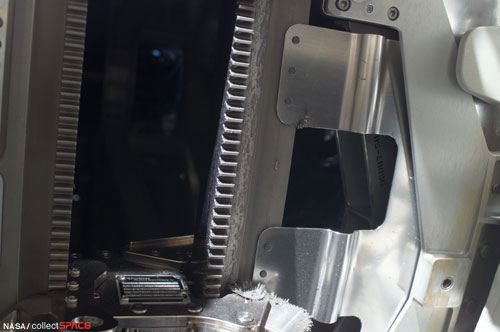 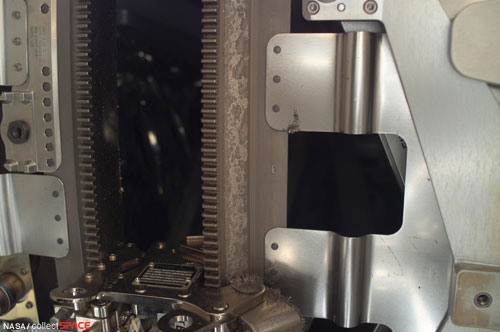
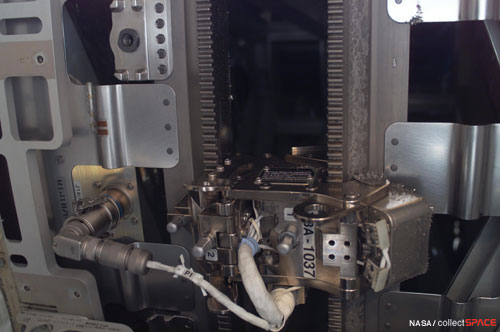
|
Robert Pearlman
Editor Posts: 46881
From: Houston, TX
Registered: Nov 1999
|
 posted 12-18-2007 11:34 AM
posted 12-18-2007 11:34 AM
   
Expedition 16 astronauts Dan Tani and Peggy Whitson wrapped up a 6 hour, 56 minute spacewalk focused on International Space Station solar array issues at 10:46 a.m. CST on Tuesday.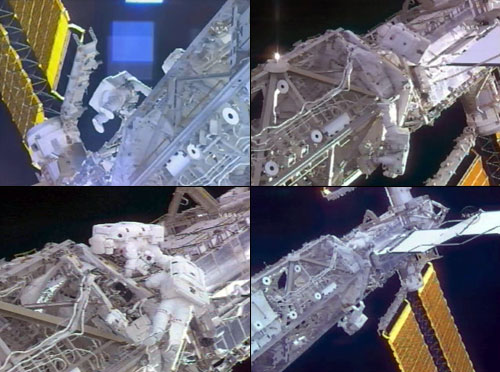 The spacewalkers looked for the cause of partial loss of electrical power to one of the station's two Beta Gimbal Assemblies (BGAs) for the starboard solar wings. They also examined damage to the starboard Solar Alpha Rotary Joint (SARJ). On Dec. 8 the BGA's primary power was lost after three circuit breakers tripped. A backup power source still functions, but because of the loss of redundancy, the device was latched with the wing in a position suitable for docking of shuttle Atlantis on STS-122. With the cables disconnected the circuits remained closed, apparently clearing the cables as suspects. Whitson reconnected them late in the spacewalk. For the BGA inspection, the spacewalkers entered the truss from opposite sides, but remained together to be able to warn one another of obstructions in that confined area. That inspection took about 45 minutes. Next the spacewalkers moved to the SARJ. Working together, they removed two large drive lock assembly covers and inspected the race rings and bearings beneath them. Then they removed and inspected beneath most of the remaining 22 covers. Their inspection on Tuesday showed various degrees of contamination under the individual covers. Generally it was similar to what had been seen previously. Finally, they removed trundle bearing assembly No. 5, one of the 12 that move along the race ring, and returned it to the station's interior. The spacewalk was the 100th for the construction and maintenance of the station. During the spacewalk, Whitson set a new record for cumulative spacewalk time by a woman. About halfway through today's spacewalk she surpassed the mark set by Sunita Williams, who had a total of 29 hours and 17 minutes during four spacewalks. Whitson's new mark is 32 hours, 36 minutes in five spacewalks. |
Robert Pearlman
Editor Posts: 46881
From: Houston, TX
Registered: Nov 1999
|
 posted 01-30-2008 12:14 PM
posted 01-30-2008 12:14 PM
   
Expedition 16 Commander Peggy Whitson and Flight Engineer Dan Tani replaced a motor at the base of one of the International Space Station's solar wings during a 7-hour, 10-minute spacewalk that ended at 11:06 a.m. CST Wednesday.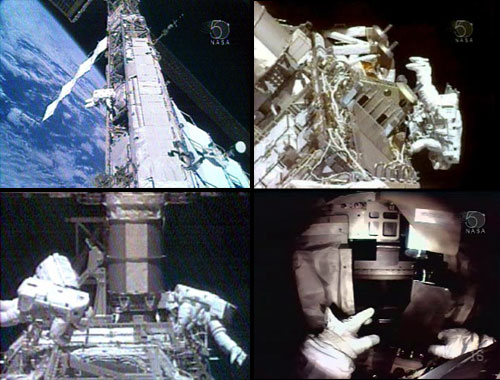 Whitson and Tani also continued their earlier inspections of the starboard solar alpha rotary joint. Most of the spacewalk focused on replacement of the motor, the Bearing Motor Roll Ring Module (BMRRM). Called the 'broom," the motor drives the starboard solar wings as they tilt along their axis to follow the sun for optimal power generation as the station orbits the Earth. Mission Control reported good electrical continuity to the new BMRRM. While spacewalkers were still outside, flight controllers completed a planned 3-degree rotation and then did a 360-degree rotation of those solar wings. Major activities of the BMRRM replacement took place during the night part of the orbit, when less voltage is generated by the solar wings than when they are exposed to the sun. The replacement BMRRM was retrieved from its stowage place in Pressurized Mating Adapter-3 early this month in preparation for the spacewalk. The motor is part of the Beta Gimbal Assembly, which experienced electrical failures Dec. 8. The removal and replacement of the BMRRM took about 3 hours, including pauses during the daylight part of the orbit. The second major task of the spacewalk was inspection of the starboard SARJ. Previous inspections revealed contamination and debris inside that joint. Eight SARJ covers were removed for Wednesday's inspection. |
PowerCat
Member Posts: 211
From: Herington, KS, USA
Registered: Feb 2006
|
 posted 09-29-2008 09:12 AM
posted 09-29-2008 09:12 AM
   
It appears that NASA has discovered the prime culprit for the S3/S4 SARJ unit contamination and breakdown: a premature loss or breakdown of a gold plating intended to lubricate the joint.According to Bill Harwood's story posted on Spaceflight Now, a repair option is being devised including installation of a new race ring. This ambitious repair plan will take until 2010 to get all components into orbit. This leads to another question... will this force NASA to extend the shuttle program to complete these tasks? |
Robert Pearlman
Editor Posts: 46881
From: Houston, TX
Registered: Nov 1999
|
 posted 09-29-2008 09:16 AM
posted 09-29-2008 09:16 AM
   
quote:
Originally posted by PowerCat:
This leads to another question... will this force NASA to extend the shuttle program to complete these tasks?
I assume that would depend on the size of the parts: if they can fit in ATV, HTV and/or Progress supply craft, then the shuttle wouldn't be needed. |

























